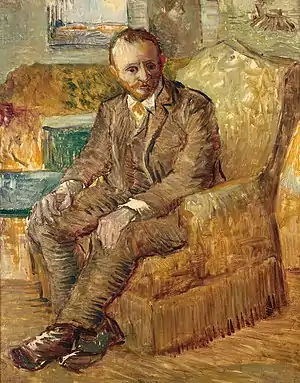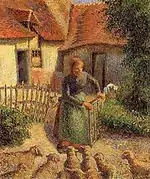Fred Jones Jr. Museum of Art
The Fred Jones Jr. Museum of Art is an art museum on the University of Oklahoma campus in Norman, Oklahoma.
.jpg.webp) | |

| |
Former name | Oklahoma University Museum of Art |
|---|---|
| Established | 1926 |
| Dissolved | 1971 |
| Location | University of Oklahoma campus, Norman, Oklahoma |
| Type | Art |
| Collections | Weitzenhoffer Collection, Fleischaker Collection, McGhee Collection, Thams Collection, State Department Collection, Eugene B. Adkins Collection, James T. Bialac Native American Art Collection, |
| Founder | Oscar Jacobson |
| Owner | University of Oklahoma |
| Website | www |
Overview
The University of Oklahoma’s Fred Jones Jr. Museum of Art holds over 20,000 objects in its permanent collection. The museum collection also includes French Impressionism, 20th-century American painting and sculpture, traditional and contemporary Native American art, the art of the Southwest, ceramics, photography, contemporary art, Asian art, and graphics from the 16th century to the present.[1]
History
The Oklahoma University Museum of Art, the forerunner of the Fred Jones Jr. Museum was founded in 1936 by OU art professor Oscar Jacobson, who became the museum's first director and served in that post until his retirement in 1950.[lower-alpha 1]
The collection continued to grow, and in 1971, a new building was built called the Fred Jones Jr. Memorial Art Center. In 1992 it was renamed the Fred Jones Jr. Museum of Art. When current OU president David Boren arrived at OU in 1994, he and his wife Molly Shi Boren began a campaign to expand the museum's collections.
In 2000 a gift of the Weitzenhoffer Collection of French Impressionism was made to the museum. In 2003, construction began to expand the museum with the addition of a new wing that was completed in 2005. The new "hut like" wing doubled the museum size; it was designed by Washington, D.C.-based architect Hugh Jacobsen.[3] The new addition is named in honor of Mary and Howard Lester of San Francisco.
In 2007, the Fred Jones Jr. Museum of Art and the Philbrook Museum of Art were named stewards of the Eugene B. Adkins Collection. To properly display OU’s portion of the collection, the University began construction in 2009 on a new level above the original structure. Opened in October 2011, the new 18,000 square-foot wing houses collections acquired within the past 15 years. Designed by architect Rand Elliott, the addition is named the Stuart Wing to honor a gift from the Stuart Family Foundation. The construction included renovations to the original 1971 building and the addition of the Eugene B. Adkins Gallery, a new photography gallery and new administrative offices. The total museum exhibition space is approximately 40,000 square feet (3,700 m2).
Ghislain d'Humières served as the Wylodean and Bill Saxon Director from 2007 to 2013. Emily Ballew Neff was appointed Wylodean and Bill Saxon Director and Chief Curator 2013-14. In 2015, Mark White was named the Wylodean and Bill Saxon Director and Eugene B. Adkins Curator. White resigned from the position in April 2020.[4]
Controversy
The Fred Jones Jr. Museum of Art's Pissarro’s ‘Shepherdess Bringing in Sheep’ was looted by the Nazis during the Second World War. The rightful owner Léone Meyer has attempted to reclaim possession, and donate the painting to the Musée d’Orsay in Paris. The Museum has refused and fought her in court to retain possession of the looted painting. “At the end of the day what the [Oklahoma] museum wants is to have the painting on the wall,” says Olivier de Baecque, the university’s lawyer in Paris.[5]
Collections
The main collections are:
- The Weitzenhoffer Collection: a collection of paintings by Impressionists, including Edgar Degas, Claude Monet, Mary Cassatt, Vincent van Gogh, Camille Pissarro, and Pierre-Auguste Renoir.[6][7][8]
- The Fleischaker Collection: a collection of more than 350 pieces of Native American and southwestern paintings, sculpture and ceramics, including works by Russian Taos painters Leon Gaspard and Nicolai Fechin.[9]
- The McGhee Collection: features Eastern Orthodox icons dating back to the 15th century.
- The Thams Collection: containing 32 paintings by members of the Taos Society of Artists.[10]
- The State Department Collection was purchased by the museum in 1948 from the controversial Advancing American Art collection. Part of the "cultural Marshall Plan," this traveling exhibit was created by the Department's Office of International Information and Cultural Affairs to demonstrate to the world America's cultural diversity and cosmopolitanism in the mid 20th century. Critics stated the exhibition portrayed an unflattering image of American life and found leftist sentiment in many of the paintings. The exhibition was dismantled by congress in 1947, after only two years, and sold to various institutions.[11] The collection includes works by Georgia O'Keeffe and Edward Hopper.
- The Eugene B. Adkins Collection: includes more than 400 paintings by American artists and examples of Native American paintings, pottery and jewelry.
- The James T. Bialac Native American Art Collection: given to the museum in 2010, the collection includes works by North America's indigenous cultures, in particular, the Pueblos of the Southwest, Navajo, Hopi, Northern and Southern Plains tribes and the Southeastern tribes. Included in the collection are approximately 2,600 paintings and works on paper, over 1,000 kachinas and approximately 400 works of varying media, including ceramics and jewelry. Works by Native artists including Fred Kabotie, Awa Tsireh, Fritz Scholder, Joe Herrera, Allan Houser, Jerome Tiger, Tonita Pena, Helen Hardin, Pablita Velarde, George Morrison, Patrick DesJarlait and Pop Chalee are represented.
Gallery
 Fred Jones Jr. Museum of Art - University of Oklahoma and "Sphinx", a monumental sculpture by Colombian artist Fernando Botero.
Fred Jones Jr. Museum of Art - University of Oklahoma and "Sphinx", a monumental sculpture by Colombian artist Fernando Botero.
Photo courtesy of Marelblu. July 15, 2012 Fred Jones Jr. Museum of Art, 2009
Fred Jones Jr. Museum of Art, 2009.jpg.webp) The Stuart Wing
The Stuart Wing Yei'bichai Dances, by Apie Begay (Navajo), watercolor on paper, 19th century, collection of the Fred Jones Jr. Museum of Art
Yei'bichai Dances, by Apie Begay (Navajo), watercolor on paper, 19th century, collection of the Fred Jones Jr. Museum of Art Portrait of Alexander Reid by Van Gogh
Portrait of Alexander Reid by Van Gogh Bergère rentrant des moutons (Shepherdess Bringing in Sheep) by Pissarro
Bergère rentrant des moutons (Shepherdess Bringing in Sheep) by Pissarro.jpg.webp) Coco (Claude) by Renoir
Coco (Claude) by Renoir La Berge à Lavacourt (Riverbank at Lavacourt) by Monet
La Berge à Lavacourt (Riverbank at Lavacourt) by Monet The Last Supper by Giordano
The Last Supper by Giordano
Notes
- Anders Oscar Jacobson (1882 - 1966) was a Swedish-born artist who immigrated with his family to Lindsborg, Kansas in 1890. He joined the OU faculty as an art professor in 1915. It originally featured only 250 works, all of which were collected by Jacobson. After a donation later that year of hundreds of pieces of East and Central Asian art by oilman Lew Wentz and photographer Gordon Matzene of Ponca City, Oklahoma, the university moved the museum to the former library building, which is now Jacobson Hall. Under Jacobson's tenure as director, the museum greatly expanded its collection of Native American art, including many works by the Kiowa Six, who had studied under Jacobson in the late 1920s. Jacobson remained as director until his retirement in 1952.[2]
References
- "The Fred Jones Jr. Museum of Art at the University of Oklahoma". Archived from the original on 2007-07-18. Retrieved 2009-06-21.
- "Fred Jones Jr. Museum of Art celebrates 100 years of artist-founder Oscar Jacobson." art daily.org. Accessed July 31, 2017
- "Archived copy". Archived from the original on 2011-10-05. Retrieved 2009-07-31.CS1 maint: archived copy as title (link)
- Kruse, Molly (1 April 2020). "Fred Jones Jr. Museum of Art director announces resignation". Retrieved 22 January 2021.
- "Fate of Pissarro painting revives row over Nazi loot" ft.com Accessed January 1, 2021
- "Archived copy". Archived from the original on 2008-12-23. Retrieved 2009-07-31.CS1 maint: archived copy as title (link)
- "Fred Jones Jr. Museum of Art".
- "OHS Publications Division".
- http://digital.libraries.ou.edu/sooner/articles/p9-15_1997v17n3_OCR.pdf
- "Alumnus adds arts to OU museum". 14 March 2003. OU Daily.
- "Archived copy". Archived from the original on 2009-07-21. Retrieved 2009-07-31.CS1 maint: archived copy as title (link)
External links
| Wikimedia Commons has media related to Fred Jones Jr. Museum of Art. |
- Fred Jones Jr. Museum of Art info, photos and video on TravelOK.com Official travel and tourism website for the State of Oklahoma
- Encyclopedia of Oklahoma History and Culture - Fred Jones Jr. Museum of Art
- Léone Meyer and University of Oklahoma Settle Nazi-looted Pissarro Dispute